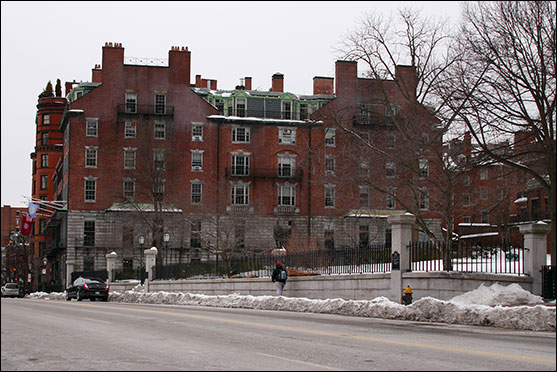
UUA sells Beacon Hill buildings to residential developer
Sea-Dar Construction will convert 25 Beacon St., Pickett & Eliot Houses into residences.
The other properties sold are 6 and 7 Mt. Vernon Place, which together are known as Pickett & Eliot Houses, a guesthouse run by the UUA. That facility, which also has provided meeting space for UU gatherings, is immediately behind 25 Beacon Street. Both properties abut the grounds of the Massachusetts State House.
The UUA’s fourth property on Beacon Hill, 41 Mt. Vernon Street, the home of Beacon Press and other UUA offices, remains on the market. The four buildings were offered individually or as a package.
Tim Brennan, the UUA’s Treasurer and Chief Financial Officer, said interest in the properties was high. He said more than 170 people signed nondisclosure agreements, 90 individuals or groups toured the properties, and there were 18 bids after the properties went on the market in September 2013.
The sale of the three properties to Sea-Dar will close on or about March 20, when the sale price will be disclosed.
The UUA can remain in 25 Beacon Street through June 30 and in Pickett & Eliot through July 31, which is one month after the guesthouse hosts its last guests.
In May the UUA and Beacon Press will move to 24 Farnsworth Street in Boston’s Seaport District. The six-story, 75,000-square-foot building was built around 1900 as a warehouse. The UUA will occupy the lower three floors, which had been gutted before the purchase and are being built out to the UUA’s requirements. The other floors have tenants, who will remain.
The move will enable the UUA to house all staff on fewer floors and will facilitate communication, collaboration, and accessibility, Brennan said. The UUA’s Beacon Hill buildings all had problems with accessibility, heating and cooling, and internet access. The elevator in 25 Beacon Street, for example, does not serve the whole height of the building. Many offices have individual air conditioners. Wiring the offices for modern communications needs was challenging and left bundles of exposed wires snaking through hallways and offices.
25 Beacon Street was built by the American Unitarian Association and opened in 1927.
Sea-Dar is a general contracting firm that has converted many older Boston-area buildings, including several on Beacon Hill, into residential units and for other purposes.
Chris Sower, managing director and partner with Boston Realty Advisors, was the broker on the transaction. He said Sea-Dar is one of the top three or four Boston companies involved in the conversion of older buildings into living units. Sea-Dar will most likely turn 25 Beacon Street into six or seven “full-floor” luxury condominiums, he said. Pickett & Eliot will probably be developed into smaller condo units, or maybe even duplexes or triplexes. He said the builder would probably investigate the possibility of an underground parking garage under Pickett & Eliot that would serve all three buildings.
Sower said the three buildings sold together because of their proximity. Nothing should be inferred, he said, by the fact the UUA’s fourth building didn’t also sell. “Those three buildings were always logically going to go together.”
View Unitarian Universalist Association Properties in a larger map
It’s rare, Sower added, for three Beacon Hill buildings so close to each other to come on the market at the same time. He said the three buildings’ proximity to the State House also helped the sale. “The joke about that is that you get landscaping you don’t have to pay for, except through your taxes.”
41 Mt. Vernon Street will likely also sell for conversion to living units, he said, adding that residential units were always going to be top of mind for any developer looking at these buildings. “That’s pretty much what the market demands.”
He said the exteriors of the buildings are required to remain mostly as they are, because Beacon Hill is one of Boston’s historic districts. “They’ll take them down to the frames and rebuild them. Pretty much everything within the shell of the buildings will be new.” He said it’s possible that some interior architectural features could be kept, but it’s too soon to know that.
He said getting the necessary permits would take six to nine months and then construction would likely begin.
Photograph (above): 25 Beacon Street on a snowy February morning, with the Massachusetts State House grounds to the right (© Kenneth Sutton/UU World). See sidebar for links to related resources.
Comments powered by Disqus






